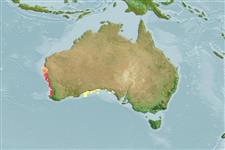Environment / Climate / Range
Ecology
Marine; reef-associated; depth range 6 - 15 m (Ref. 57886). Temperate, preferred ?; 25°S - 34°S (Ref. 57886)
Eastern Indian Ocean: Western Australia.
Size / Weight / Age
Maturity: Lm ? range ? - ? cm
Max length : 19.7 cm SL male/unsexed; (Ref. 57886); 16.2 cm SL (female)
Short description
Morphology | Morphometrics
Dorsal
soft rays
(total): 161-191;
Anal
soft rays: 109 - 124;
Vertebrae: 79 - 87. The species is distinguished in having a very elongate, almost eel-like body; vertebrae 22-25 + 57-65 = 79-87, dorsal fin rays 161-191, anal fin rays 109-124, D/A 58-75, V/A 27-28; no scales; no supraorbital pore behind eye; lower preopercular pores 2; posterior infraorbital pores 3; broad angle on ventral maxilla positioned behind rear of eye; exposed opercular spine small, short, straight; lower lip with prominent skin folds; single pair of pseudoclaspers curved outwards, with narrow base and pointed tip, with broadly expanded fleshy flaps anteriorly and posteriorly; penis small, less than half the length of pseudoclaspers, with hook at tip; otoliths
pointed anteriorly, rounded posteriorly, predorsal angle more pronounced than postdorsal angle (Ref. 57886).
Uncommon species inhabiting shallow reefs (Ref. 34024). A benthic species (Ref. 75154).
Life cycle and mating behavior
Maturity | Reproduction | Spawning | Eggs | Fecundity | Larvae
Møller, P.R. and W. Schwarzhans, 2006. Review of the Dinematichthyini (Teleostei, Bythitidae) of the Indo-west Pacific, Part II. Dermatopsis, Dermatopsoides and Dipulus with description of six new species. The Beagle 22:39-76. (Ref. 57886)
IUCN Red List Status (Ref. 115185)
CITES (Ref. 94142)
Not Evaluated
Threat to humans
Harmless
Human uses
Fisheries: of no interest
More information
Age/SizeGrowthLength-weightLength-lengthLength-frequenciesMorphometricsMorphologyLarvaeLarval dynamicsRecruitmentAbundance
ReferencesAquacultureAquaculture profileStrainsGeneticsAllele frequenciesHeritabilityDiseasesProcessingMass conversion
Tools
Special reports
Download XML
Internet sources
